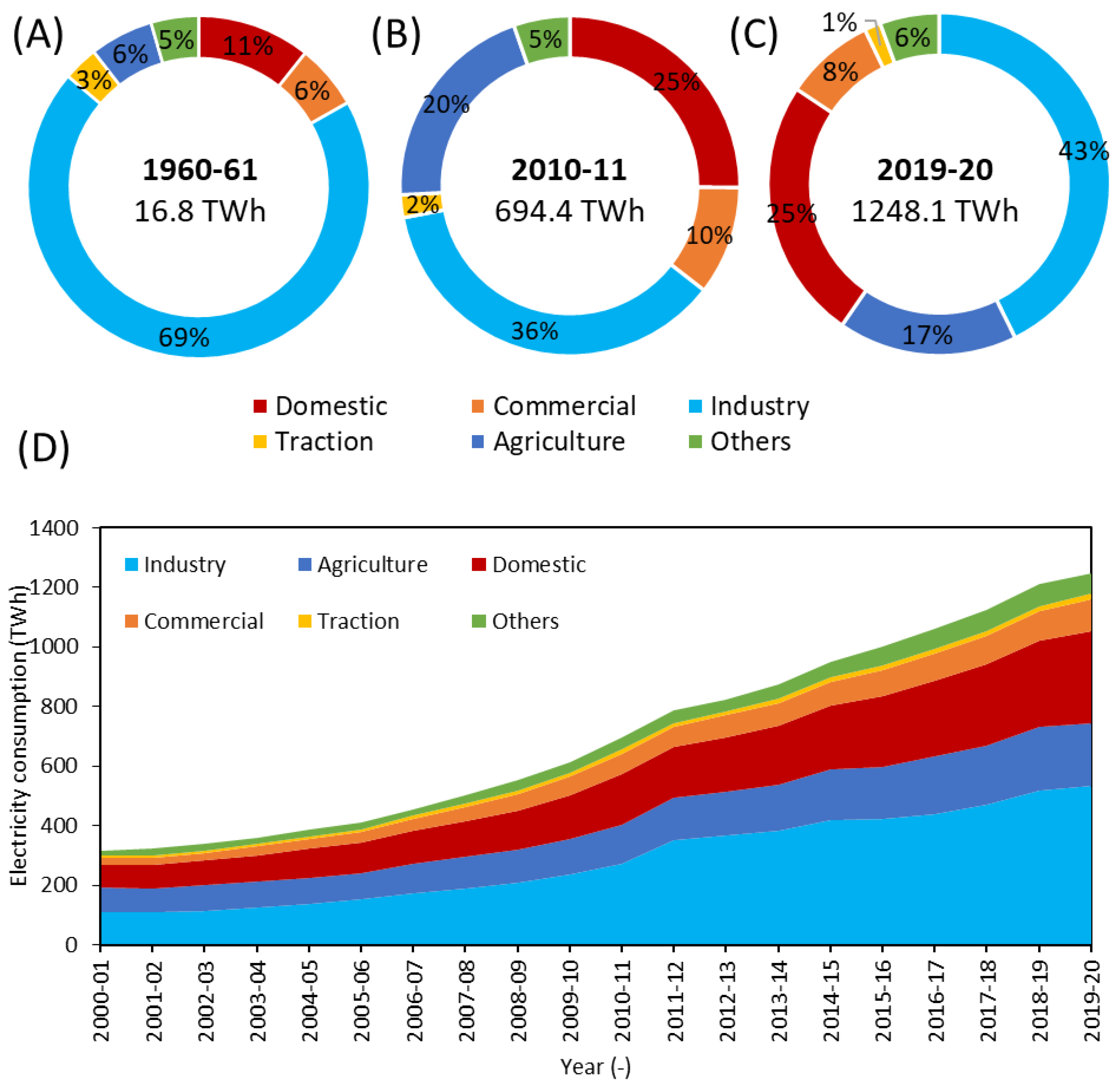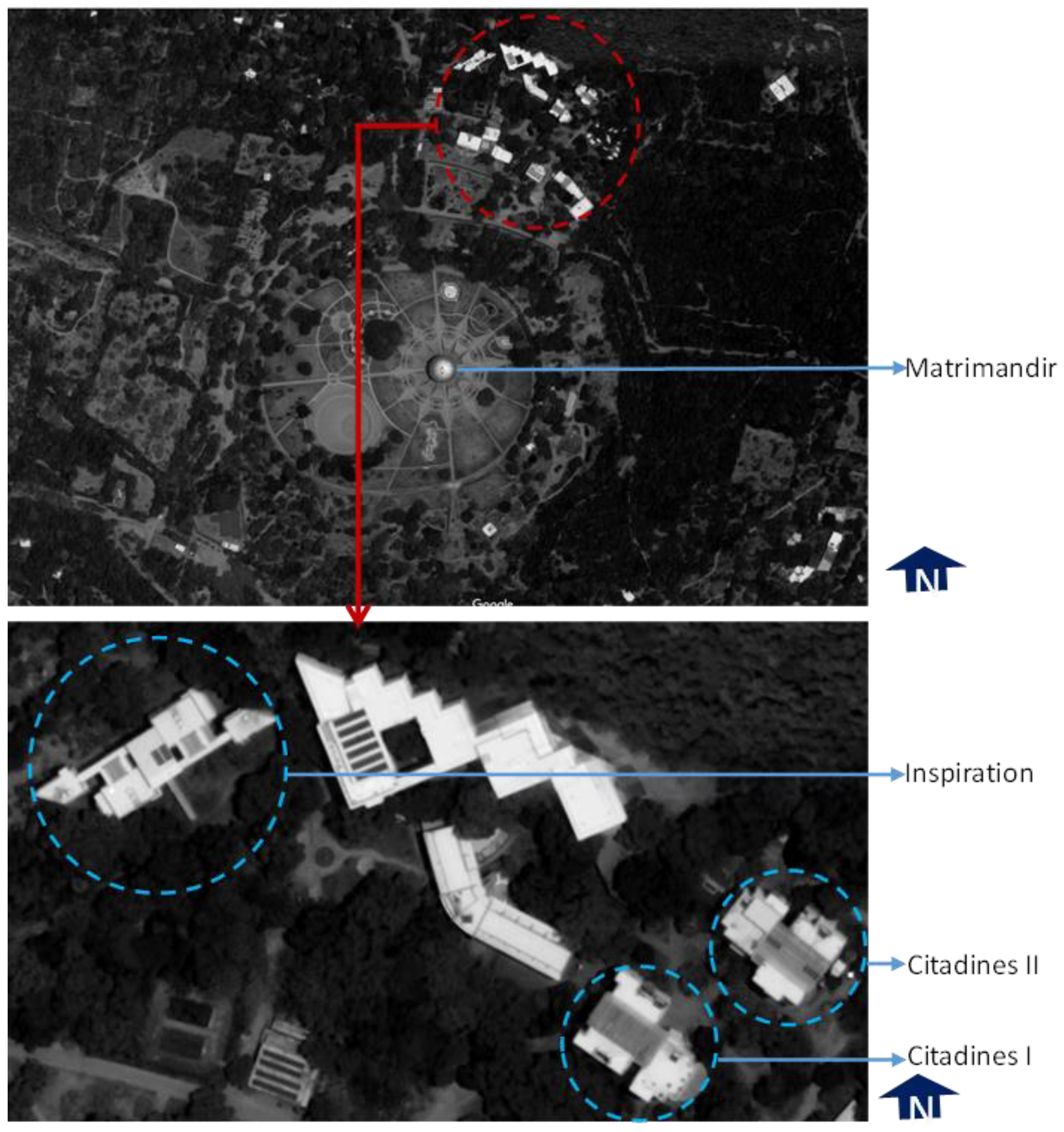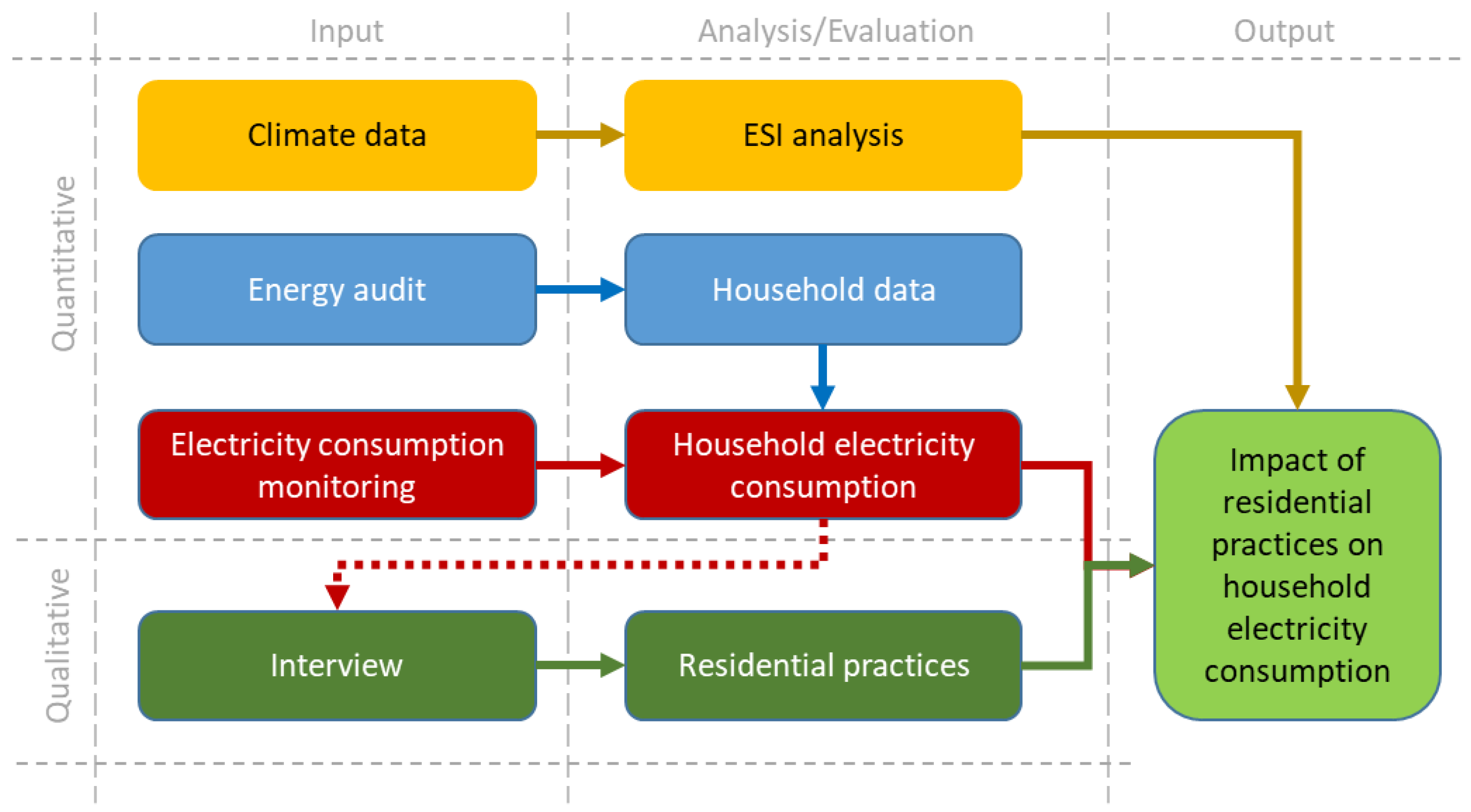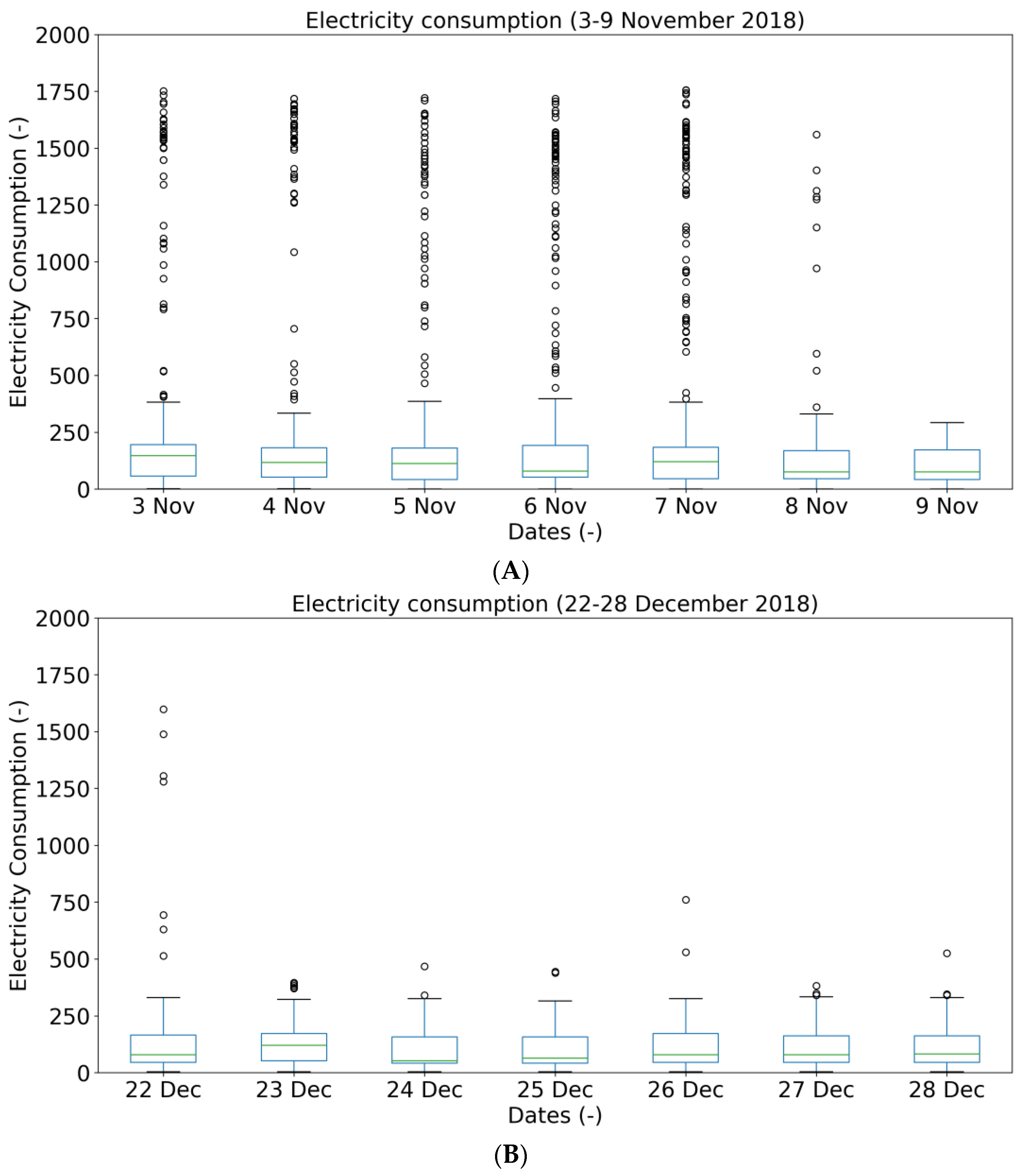A Mixed-Methods Approach for Evaluating the Influence of Residential Practices for Thermal Comfort on Electricity Consumption in Auroville, India
Abstract
:1. Introduction

2. Methodology
2.1. Environmental Stress Index (ESI) Analysis
2.2. Case Study Details
2.3. Data Collection
2.3.1. End-User Metering and Electricity Consumption Monitoring
2.3.2. The Ethnographic Approach through Interviews and Observations
2.3.3. Limitation
2.4. Mixed Method Approach
3. Results and Discussion
3.1. Climate Change and Heat Stress in Auroville
3.2. Electricity Consumption and Practices in Case Studies
3.2.1. Case Study: Home 1
- Demand profile analysis
- Householder account on observed electricity and cooling consumption patterns
“I turn on the AC more, maybe for two hours, I run it, and then I shut it down, and I have the fan going after that until the morning.”
- Technological choice: a belief that purchasing energy-efficient technology allowed the participant to run his A/C for as long as he wanted;
- Know-how on A/C use: the participant developed an alternating system between his A/C and fanned to maintain comfort at home. The system allowed him to maintain a sense of energy conservation while still using his A/C when ‘needed’;
- Physiological and passionate attachment to A/C: the participant connected his use of A/C to his health and placed a high emotional attachment to his ability to attain comfort using the system;
- Changes in electricity system: The participant justified his frequent use of A/C because his community-generated electricity is from renewable sources, reducing his environmental footprint.
3.2.2. Case study: Home 5
- Demand profile analysis
- Householders account for observed electricity and cooling consumption patterns
“The problem is, if I leave the main door open, I have mosquitoes coming in, which is the issue. I would love to have everything open, but I cannot do that because if you leave the door open for not even five minutes and you have mosquitoes inside, it is just a pain.”
- The materiality of building design: Although his apartment was semi-passive, it was poorly designed, failing to meet his thermal comfort requirement.
- Know-how on maintaining ventilation: The participant developed a unique method of mixing mechanical and natural approaches to attain thermal comfort.
- Physiological and emotive impacts: Sleep was the primary driver for the continual use of fans. The participants’ striving for emotional well-being shaped his cooling practices.
- Know-how on electricity consumption: the participant started monitoring his consumption, which allowed him to identify that his current fans consume more. However, his choice to buy a more energy-efficient fan might also result in a rebound effect (i.e., using the fan more because of its presumed level of energy efficiency).
4. Conclusions
Author Contributions
Funding
Institutional Review Board Statement
Informed Consent Statement
Data Availability Statement
Acknowledgments
Conflicts of Interest
References
- WB. World Development Indicators (WDI). 2023. Available online: http://databank.worldbank.org/data/source/world-development-indicators (accessed on 5 December 2023).
- UN. UN DESA Policy Brief No. 153: India Overtakes China as the World’s Most Populous Country. 24 April 2023. Available online: https://www.un.org/development/desa/dpad/publication/un-desa-policy-brief-no-153-india-overtakes-china-as-the-worlds-most-populous-country/ (accessed on 31 October 2023).
- WEF. Future of Consumption in Fast-Growth Consumer Markets: INDIA; World Economic Forum: Colony, Switzerland, 2019. [Google Scholar]
- Biardeau, L.T.; Davis, L.W.; Gertler, P.; Wolfram, C. Heat exposure and global air conditioning. Nat. Sustain. 2020, 3, 25–28. [Google Scholar] [CrossRef]
- Sivak, M. Potential energy demand for cooling in the 50 largest metropolitan areas of the world: Implications for developing countries. Energy Policy 2009, 37, 1382–1384. [Google Scholar] [CrossRef]
- Debnath, K.B.; Jenkins, D.; Patidar, S.; Peacock, A.D.; Bridgens, B. Climate change, extreme heat, and South Asian megacities: Impact of heat stress on inhabitants and their productivity. ASME J. Eng. Sustain. Build. Cities 2023, 4, 041006. [Google Scholar] [CrossRef]
- GoI. India Energy Security Scenarios 2047. 2015. Available online: http://iess2047.gov.in/ (accessed on 20 October 2019).
- IEA. Energy Efficiency: Cooling. 2019. Available online: https://www.iea.org/topics/energyefficiency/buildings/cooling/ (accessed on 20 October 2019).
- GBPN; CEPT. Residential Buildings in India: Energy Use Projections and Savings Potentials; Global Buildings Performance Network (GBPN): Ahmedabad, India, 2014. [Google Scholar]
- IEA. Electricity Final Consumption by Sector, India 1990–2017. 2020. Available online: https://www.iea.org/data-and-statistics?country=INDIA&fuel=Energy%20consumption&indicator=Electricity%20final%20consumption%20by%20sector (accessed on 5 December 2020).
- GoI. India Cooling Action Plan; Government of India: New Delhi, India, 2019.
- Abhyankar, N.; Shah, N.; Park, W.Y.; Phadke, A. Accelerating Energy Efficiency Improvements in Room Air Conditioners in India: Potential, Costs-Benefits, and Policies; Ernest Orlando Lawrence Berkeley National Laboratory: Berkeley, CA, USA, 2017.
- Tweed, C.; Dixon, D.; Hinton, E.; Bickerstaff, K. Thermal comfort practices in the home and their impact on energy consumption. Archit. Eng. Des. Manag. 2014, 10, 1–24. [Google Scholar] [CrossRef]
- Costa-Carrapiço, I.; González, J.N.; Raslan, R.; Sánchez-Guevara, C.; Marrero, M.D.R. Understanding thermal comfort in vernacular dwellings in Alentejo, Portugal: A mixed-methods adaptive comfort approach. Build. Environ. 2022, 217, 109084. [Google Scholar] [CrossRef]
- Milando, C.W.; Black-Ingersoll, F.; Heidari, L.; López-Hernández, I.; de Lange, J.; Negassa, A.; McIntyre, A.M.; Martinez, M.P.B.; Bongiovanni, R.; Levy, J.I.; et al. Mixed methods assessment of personal heat exposure, sleep, physical activity, and heat adaptation strategies among urban residents in the Boston area, MA. BMC Public Health 2022, 22, 2314. [Google Scholar] [CrossRef] [PubMed]
- Eslamirad, N.; Sepúlveda, A.; De Luca, F.; Lylykangas, K.S. Evaluating outdoor thermal comfort using a mixed-method to improve the environmental quality of a university campus. Energies 2022, 15, 1577. [Google Scholar] [CrossRef]
- Eon, C.; Morrison, G.M.; Byrne, J. The influence of design and everyday practices on individual heating and cooling behaviour in residential homes. Energy Effic. 2018, 11, 273–293. [Google Scholar] [CrossRef]
- TSharmin, T.; Khalid, R. Post occupancy and participatory design evaluation of a marginalized low-income settlement in Ahmedabad, India. Build. Res. Inf. 2022, 50, 574–594. [Google Scholar] [CrossRef]
- GoI. Consumption of Electricity (From Utility) by Sectors. 1 November 2023. Available online: https://data.gov.in/catalog/consumption-electricity-utility-sectors (accessed on 4 November 2023).
- GoI. Growth of Electricity Sector in India 1947–2013; Government of India: New Delhi, India, 2013.
- Chaturvedi, V.; Eom, J.; Clarke, L.E.; Shukla, P.R. Long term building energy demand for India: Disaggregating end use energy services in an integrated assessment modeling framework. Energy Policy 2014, 64, 226–242. [Google Scholar] [CrossRef]
- Verma, A.; Jaiswal, Y.K.; Wani, K.A. Energy consumption behaviour of an urban residential sector in the northern province of Madhya Pradesh (India). Indoor Built Environ. 2012, 21, 703–709. [Google Scholar] [CrossRef]
- Yu, S.; Evans, M.; Kyle, P.; Vu, L.; Tan, Q.; Gupta, A.; Patel, P. Implementing nationally determined contributions: Building energy policies in India’s mitigation strategy. Environ. Res. Lett. 2018, 13, 034034. [Google Scholar] [CrossRef]
- Jensen, C.L.; Goggins, G.; Fahy, F.; Grealis, E.; Vadovics, E.; Genus, A.; Rau, H. Towards a practice-theoretical classification of sustainable energy consumption initiatives: Insights from social scientific energy research in 30 European countries. Energy Res. Soc. Sci. 2018, 45, 297–306. [Google Scholar] [CrossRef]
- Shove, E.; Walker, G. Governing transitions in the sustainability of everyday life. Res. Policy 2010, 39, 471–476. [Google Scholar] [CrossRef]
- Schatzki, T.R. The Site of the Social: A Philosophical Account of the Constitution of Social Life and Change; Penn State Press: University Park, PA, USA, 2002. [Google Scholar]
- Gram-Hanssen, K. Understanding change and continuity in residential energy consumption. J. Consum. Cult. 2011, 11, 61–78. [Google Scholar] [CrossRef]
- Shove, E.; Watson, M.; Spurling, N. Conceptualizing connections: Energy demand, infrastructures and social practices. Eur. J. Soc. Theory 2015, 18, 274–287. [Google Scholar] [CrossRef]
- Warde, A. Consumption and theories of practice. J. Consum. Cult. 2005, 5, 131–153. [Google Scholar] [CrossRef]
- Winther, T.; Wilhite, H. An analysis of the household energy rebound effect from a practice perspective: Spatial and temporal dimensions. Energy Effic. 2015, 8, 595–607. [Google Scholar] [CrossRef]
- Chandel, S.; Sarkar, A. Performance assessment of a passive solar building for thermal comfort and energy saving in a hilly terrain of India. Energy Build. 2015, 86, 873–885. [Google Scholar] [CrossRef]
- AVC. Analysis of Auroville’s Electricity 2010–2017; Auroville Consulting: Auroville, India, 2018. [Google Scholar]
- AF. The Line of Goodwill—An Urban Hillscape for Coexistence. 2017. Available online: https://www.auroville.org/page/the-line-of-goodwill-an-urban-hillscape-for-coexistence (accessed on 10 September 2019).
- AF. Auroville Green Practices. 2020. Available online: https://auroville.org/category/green-practices (accessed on 1 April 2020).
- Kundoo, A. Auroville: An Architectural Laboratory. Archit. Des. 2007, 77, 50–55. [Google Scholar] [CrossRef]
- Kapoor, R. Auroville: A spiritual-social experiment in human unity and evolution. Futures 2007, 39, 632–643. [Google Scholar] [CrossRef]
- Nagy, B. Experimented methods to moderate the impact of climate change in Auroville. Ecocycles 2018, 4, 20–31. [Google Scholar] [CrossRef]
- LLoret, S.; Martin, S.; Sarkhot, D. Sustainable Energy in Auroville the Vision and the Reality; IIT Madras, India, Auroville; Ecole Polytechnique Federale de Lausanne: Guy Brown, Switzerland, 2002. [Google Scholar]
- Meteoblue. Meteoblue. 2023. Available online: www.meteoblue.com (accessed on 23 March 2023).
- Moran, D.; Pandolf, K.; Shapiro, Y.; Heled, Y.; Shani, Y.; Mathew, W.; Gonzalez, R. An environmental stress index (ESI) as a substitute for the wet bulb globe temperature (WBGT). J. Therm. Biol. 2001, 26, 427–431. [Google Scholar] [CrossRef]
- Liang, C.; Zheng, G.; Zhu, N.; Tian, Z.; Lu, S.; Chen, Y. A new environmental heat stress index for indoor hot and humid environments based on Cox regression. J. Affect. Disord. 2011, 46, 2472–2479. [Google Scholar] [CrossRef]
- Zare, S.; Shirvan, H.E.; Hemmatjo, R.; Sarebanzadeh, K.; Hasheminejad, N.; Faridan, M.; Zare, K. Investigating the levels of thermal stress in kerman city in 2016 using thermal indices: WBGT, ESI, HI, HSI, and SWreq. J. Kerman Univ. Med. Sci. 2018, 25, 339–354. [Google Scholar]
- Taleghani, M.; Tenpierik, M.; Kurvers, S.; van den Dobbelsteen, A. A review into thermal comfort in buildings. Renew. Sustain. Energy Rev. 2013, 26, 201–215. [Google Scholar] [CrossRef]
- Moran, D.; Pandolf, K.; Shapiro, Y.; Laor, A.; Heled, Y.; Gonzalez, R. Evaluation of the environmental stress index for physiological variables. J. Therm. Biol. 2003, 28, 43–49. [Google Scholar] [CrossRef]
- Moran, D.S.; Pandolf, K.B.; Vitalis, A.; Heled, Y.; Parker, R.; Gonzalez, R.R. Evaluation of the environmental stress index (ESI) for the southern hemisphere. J. Therm. Biol. 2004, 29, 535–538. [Google Scholar] [CrossRef]
- Auroville. Auroville in Brief. 2017. Available online: https://auroville.org/page/brief (accessed on 10 May 2019).
- Google Earth. Map showing Location of Auroville. 2019. Available online: https://www.google.com/maps (accessed on 24 December 2019).
- Shove, E.; Walker, G. What Is Energy For? Social Practice and Energy Demand. Theory Cult. Soc. 2014, 31, 41–58. [Google Scholar] [CrossRef]
- Debnath, K.B.; Jenkins, D.P.; Patidar, S.; Peacock, A.D. Understanding Residential Occupant Cooling Behaviour through Electricity Consumption in Warm-Humid Climate. Buildings 2020, 10, 78. [Google Scholar] [CrossRef]
- Guleria, S.; Gupta, A.K. Heat Wave in India Documentation of State of Telangana and Odisha (2016); National Institute of Disaster Management: New Delhi, India, 2018.
- WEC. Average Electricity Consumption per Electrified Household. 2020. Available online: https://wec-indicators.enerdata.net/household-electricity-use.html (accessed on 28 June 2020).
- McCallum, P.; Jenkins, D.P.; Peacock, A.D.; Patidar, S.; Andoni, M.; Flynn, D.; Robu, V. A multi-sectoral approach to modelling community energy demand of the built environment. Energy Policy 2019, 132, 865–875. [Google Scholar] [CrossRef]
- Jenkins, D.; Patidar, S.; McCallum, P.; Debnath, K. Modelling community electricity demand for UK and India. Sustain. Cities Soc. 2020, 55, 102054. [Google Scholar] [CrossRef]










| Occupant | Area | |
|---|---|---|
| Mean | 1.2 | 47.6 |
| Standard Error | 0.1 | 2.6 |
| Median | 1.0 | 50.0 |
| Mode | 1.0 | 50.0 |
| Standard Deviation | 0.4 | 11.5 |
| Sample Variance | 0.1 | 132.6 |
| Kurtosis | 2.8 | 1.1 |
| Skewness | 2.1 | 0.8 |
| Range | 1.0 | 45.0 |
| Minimum | 1.0 | 30.0 |
| Maximum | 2.0 | 75.0 |
| Sum | 23.0 | 952.0 |
| Count | 20.0 | 20.0 |
| Lighting | HVAC and Hot Water | Entertainment and IT | ||||||||||||||||
|---|---|---|---|---|---|---|---|---|---|---|---|---|---|---|---|---|---|---|
| Tungsten Filament (5–15 W) | CFL (5–18 W) | T5 with Electronic Ballast (5–15W) | LED (2–15 W) | Fan (25–75 W) | A/C (1000 W) | Geyser (3000 W) | Laptop (20–60 W) | CPU (72.5 W) | Monitor (17.6 W) | Modem (12 W) | Router (7.65–21.6 W) | Hard disk (18 W) | Speakers (0.07–15 W) | Television (200 W) | Set-top box | Music system (150 W) | Phone | |
| Mean | 1.0 | 5.4 | 1.7 | 2.3 | 3.1 | 0.1 | 0.4 | 0.6 | 0.2 | 0.2 | 0.1 | 0.1 | 0.1 | 0.1 | 0.2 | 0.1 | 0.1 | 0.1 |
| Standard Error | 0.4 | 0.7 | 0.5 | 1.1 | 0.2 | 0.1 | 0.1 | 0.1 | 0.1 | 0.1 | 0.1 | 0.1 | 0.1 | 0.1 | 0.1 | 0.1 | 0.1 | 0.1 |
| Median | 0.0 | 6.0 | 0.5 | 1.0 | 3.0 | 0.0 | 0.0 | 1.0 | 0.0 | 0.0 | 0.0 | 0.0 | 0.0 | 0.0 | 0.0 | 0.0 | 0.0 | 0.0 |
| Mode | 0 | 5 | 0 | 0 | 3 | 0 | 0 | 1 | 0 | 0 | 0 | 0 | 0 | 0 | 0 | 0 | 0 | 0 |
| Standard Deviation | 1.8 | 3.3 | 2.0 | 4.7 | 1.0 | 0.3 | 0.5 | 0.6 | 0.4 | 0.4 | 0.2 | 0.3 | 0.2 | 0.3 | 0.4 | 0.2 | 0.2 | 0.2 |
| Sample Variance | 3.3 | 10.9 | 4.1 | 22.2 | 1.0 | 0.1 | 0.3 | 0.4 | 0.1 | 0.2 | 0.1 | 0.1 | 0.1 | 0.1 | 0.1 | 0.1 | 0.1 | 0.1 |
| Kurtosis | 6.0 | −0.4 | −1.4 | 14.6 | −0.4 | 7.0 | −2.0 | −0.6 | 2.8 | 0.7 | 20.0 | 7.0 | 20.0 | 7.0 | 2.8 | 20.0 | 20.0 | 20.0 |
| Skewness | 2.4 | −0.3 | 0.6 | 3.7 | −0.1 | 2.9 | 0.4 | 0.4 | 2.1 | 1.6 | 4.5 | 2.9 | 4.5 | 2.9 | 2.1 | 4.5 | 4.5 | 4.5 |
| Range | 7 | 12 | 5 | 21 | 4 | 1 | 1 | 2 | 1 | 1 | 1 | 1 | 1 | 1 | 1 | 1 | 1 | 1 |
| Minimum | 0 | 0 | 0 | 0 | 1 | 0 | 0 | 0 | 0 | 0 | 0 | 0 | 0 | 0 | 0 | 0 | 0 | 0 |
| Maximum | 7 | 12 | 5 | 21 | 5 | 1 | 1 | 2 | 1 | 1 | 1 | 1 | 1 | 1 | 1 | 1 | 1 | 1 |
| Sum | 19 | 108 | 34 | 45 | 61 | 2 | 8 | 12 | 3 | 4 | 1 | 2 | 1 | 2 | 3 | 1 | 1 | 1 |
| Count | 20 | 20 | 20 | 20 | 20 | 20 | 20 | 20 | 20 | 20 | 20 | 20 | 20 | 20 | 20 | 20 | 20 | 20 |
| Cooking and Food Related | Others | |||||||||||
|---|---|---|---|---|---|---|---|---|---|---|---|---|
| Refrigerator (100–548 kWh/year) | Oven (1200–1300 W) | Electric Stove (1000–1200 W) | Coffee Machine (800 W) | Mixer (800 W) | Blender (500 W) | Kettle [Water Heater] (180–1800 W) | Toaster (800 W) | Vacuum Cleaner (1400 W) | Iron (750–1400 W) | Mix Table | Hairdryer (2500 W) | |
| Mean | 1.0 | 0.1 | 0.1 | 0.1 | 0.2 | 0.2 | 0.3 | 0.1 | 0.1 | 0.2 | 0.1 | 0.1 |
| Standard Error | 0.1 | 0.1 | 0.1 | 0.1 | 0.1 | 0.1 | 0.1 | 0.1 | 0.1 | 0.1 | 0.1 | 0.1 |
| Median | 1.0 | 0.0 | 0.0 | 0.0 | 0.0 | 0.0 | 0.0 | 0.0 | 0.0 | 0.0 | 0.0 | 0.0 |
| Mode | 1 | 0 | 0 | 0 | 0 | 0 | 0 | 0 | 0 | 0 | 0 | 0 |
| Standard Deviation | 0.3 | 0.3 | 0.3 | 0.2 | 0.4 | 0.4 | 0.4 | 0.3 | 0.2 | 0.4 | 0.2 | 0.2 |
| Sample Variance | 0.1 | 0.1 | 0.1 | 0.1 | 0.1 | 0.2 | 0.2 | 0.1 | 0.1 | 0.1 | 0.1 | 0.1 |
| Kurtosis | 9.5 | 7.0 | 7.0 | 20.0 | 2.8 | 0.7 | −0.5 | 7.0 | 20.0 | 2.8 | 20.0 | 20.0 |
| Skewness | 0.0 | 2.9 | 2.9 | 4.5 | 2.1 | 1.6 | 1.3 | 2.9 | 4.5 | 2.1 | 4.5 | 4.5 |
| Range | 2 | 1 | 1 | 1 | 1 | 1 | 1 | 1 | 1 | 1 | 1 | 1 |
| Minimum | 0 | 0 | 0 | 0 | 0 | 0 | 0 | 0 | 0 | 0 | 0 | 0 |
| Maximum | 2 | 1 | 1 | 1 | 1 | 1 | 1 | 1 | 1 | 1 | 1 | 1 |
| Sum | 20 | 2 | 2 | 1 | 3 | 4 | 5 | 2 | 1 | 3 | 1 | 1 |
| Count | 20 | 20 | 20 | 20 | 20 | 20 | 20 | 20 | 20 | 20 | 20 | 20 |
Disclaimer/Publisher’s Note: The statements, opinions and data contained in all publications are solely those of the individual author(s) and contributor(s) and not of MDPI and/or the editor(s). MDPI and/or the editor(s) disclaim responsibility for any injury to people or property resulting from any ideas, methods, instructions or products referred to in the content. |
© 2024 by the authors. Licensee MDPI, Basel, Switzerland. This article is an open access article distributed under the terms and conditions of the Creative Commons Attribution (CC BY) license (https://creativecommons.org/licenses/by/4.0/).
Share and Cite
Debnath, K.B.; Osunmuyiwa, O.; Jenkins, D.P.; Peacock, A.D. A Mixed-Methods Approach for Evaluating the Influence of Residential Practices for Thermal Comfort on Electricity Consumption in Auroville, India. Electricity 2024, 5, 112-133. https://doi.org/10.3390/electricity5010007
Debnath KB, Osunmuyiwa O, Jenkins DP, Peacock AD. A Mixed-Methods Approach for Evaluating the Influence of Residential Practices for Thermal Comfort on Electricity Consumption in Auroville, India. Electricity. 2024; 5(1):112-133. https://doi.org/10.3390/electricity5010007
Chicago/Turabian StyleDebnath, Kumar Biswajit, Olufolahan Osunmuyiwa, David P. Jenkins, and Andrew D. Peacock. 2024. "A Mixed-Methods Approach for Evaluating the Influence of Residential Practices for Thermal Comfort on Electricity Consumption in Auroville, India" Electricity 5, no. 1: 112-133. https://doi.org/10.3390/electricity5010007







